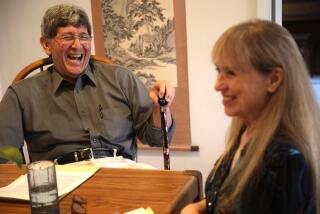For breast cancer patients, a surgical alternative
- Share via
Breast cancer survivor Taryn Heeber-Doody faced tough choices earlier this year when her doctor felt troubling changes in the tissue of her healthy breast.
The doctor suggested a double mastectomy to reduce the chance that the cancer removed six years ago would return to threaten her life.
That part was a no-brainer for the Enfield, Conn., paralegal. She was 39 with a husband and two sons; of course, she would do anything to safeguard her life.
At the same time, she felt awfully young to have to go through what were supposed to be the best years of her life with a disfigured chest.
Implants or surgical reconstruction were options.
But she didn’t like the idea that implants are fake, and after some research she discovered her previous radiation treatment ruled them out anyway.
Conventional breast reconstruction also had a serious downside. To create new breasts with the decades-old approach, plastic surgeons lift skin, fat and muscle from the abdomen and use it to replace tissue removed during cancer surgery.
The result is replacement breasts that look and feel natural. But the abdomen can be left weak, with little or no muscle remaining to assist in sitting up to get out of bed, lifting a grocery bag or participating in many athletic activities.
“You sacrifice the six-pack muscles in front of the abdomen,” said Dr. Hooman Soltanian, a plastic surgeon at Saint Francis Hospital and Medical Center in Hartford. “It means the abdominal wall is going to be very weak.”
Though Heeber-Doody is not much of an athlete, she relies on her stomach muscles to take the pressure off her bad back.
“I was scared that my only option was having no stomach muscles,” said Heeber-Doody, who is bothered by a slightly bulged disc in her spine.
Then she found Soltanian, who is among a handful of plastic surgeons outside large academic medical centers who perform a newer, more complex reconstruction technique that spares the abdominal muscles while rebuilding the breasts.
The new approach has evolved from huge advances in the art and science of microsurgery, which allows surgeons to use a high-powered microscope and tiny tools to see and stitch together veins and arteries whose diameters are about the size of the tip of a ballpoint pen.
Before microsurgery, the only way to transfer living tissue from one spot in the body to another was to move the needed tissue without disconnecting its blood supply. To build a new breast, for example, the surgeon would create a flap of muscle, skin and fat from the abdomen. Because blood vessels travel within the muscle, the muscle had to be included. Leaving the vessels attached, the surgeon then flipped the abdominal flap up onto the chest, where it was reattached to form a breast.
With the newer approach, Soltanian did not have to remove muscle from the abdomen. Instead, he isolated a vein and artery from within the muscle and removed a chunk of skin and fat that he would use to create a new breast for Heeber-Doody, leaving almost all of the muscle intact.
Soltanian then attached the replacement tissue to the breast area and stitched the thread-thin blood vessels to vessels he had isolated in the chest.
“You can see immediately when you remove the clamps how the blood starts circulating,” Soltanian said.
Dr. Rajiv Chandawarkar, a plastic surgeon at the University of Connecticut Health Center in Farmington who also performs the muscle-saving breast reconstruction, said reconnecting the blood vessels was akin to unplugging an electrical cord from one socket and plugging it into another.
The result, Soltanian said, is replacement breasts made from natural tissue that lives and resists infection much like any other part of the body.
The muscle-sparing surgery is ideal for younger patients who are athletic or need to retain their abdominal strength to care for a family or work at a strenuous job.
But rebuilding both breasts also requires at least eight hours in the operating room, a hospital stay of five days or more and a slightly longer recovery time than more conventional reconstruction. So, Chandawarkar said, it is important that patients weigh their lifestyles against the risks and benefits of all approaches. For less active patients, the older approach may be just fine, he said.
Patients must also consult their oncologist and cancer surgeon to ensure that reconstruction can be done safely, without increasing the risk that a recurrence of cancer might be overlooked.
Heeber-Doody likened her breast reconstruction to a gift after her cancer scare. As a bonus in the muscle-sparing approach, the surgeon removes virtually all of the extra fat from the abdomen, leaving patients with what is essentially a tummy tuck.
Heeber-Doody said her breasts look and feel natural and she’s never looked better in a bathing suit.
Soltanian said breast reconstruction should not be taken lightly. But knowing that natural-looking reconstruction is possible and can even leave a patient looking buff might encourage women who are fearful of breast cancer to check out suspicious lumps instead of ignoring them. “My hope,” he said, “is I can take the fear of not having a breast out of the equation so that when women feel something, they don’t wait.”






